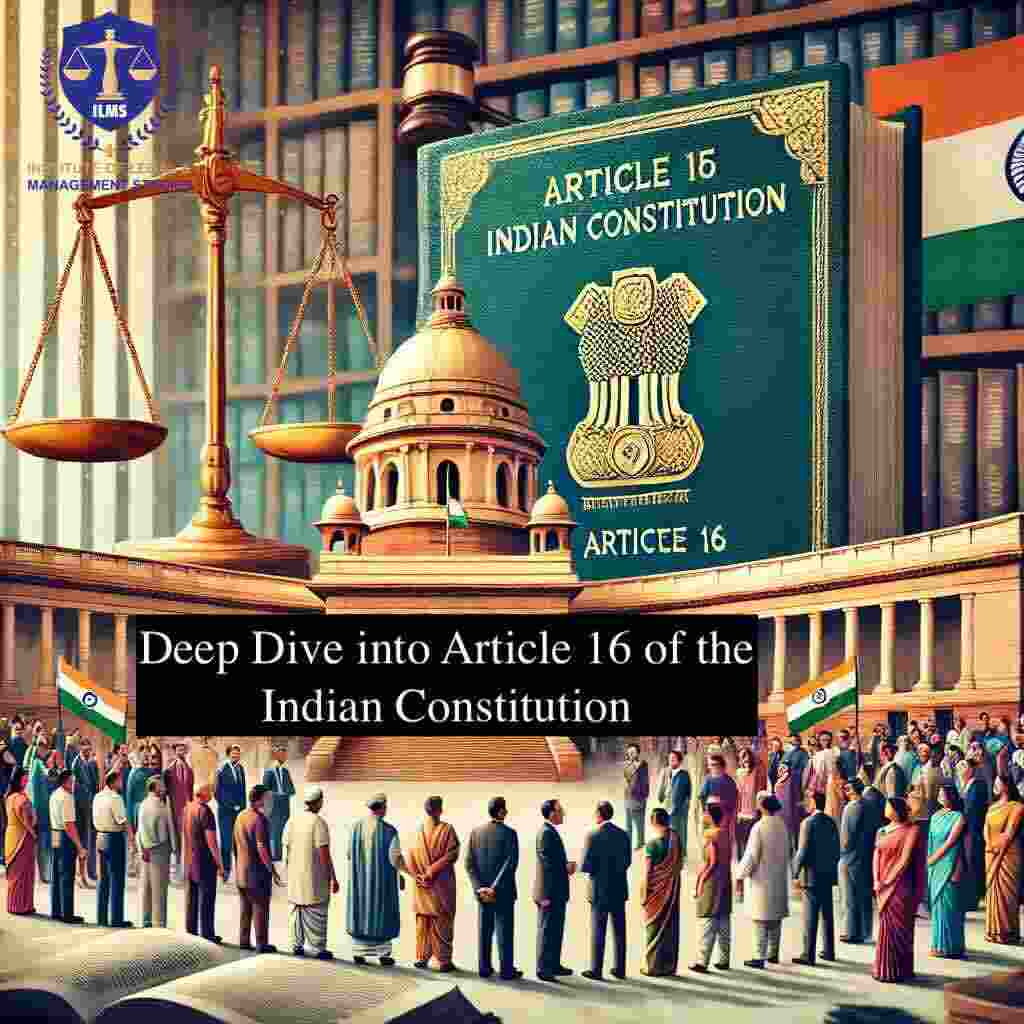Table of Contents
- Introduction
- Legal Framework of Article 16
- Provisions of Article 16
- Reservations in Public Employment
- Landmark Cases Interpreting Article 16
- Exceptions to Article 16
- The Relationship Between Article 16 and Other Constitutional Provisions
- Contemporary Debates and Controversies
- Implementing Article 16 in Practice
- Conclusion
1. Introduction
The Indian Constitution, in its quest to ensure equality for all citizens, includes multiple provisions that ensure that no individual is discriminated against on arbitrary grounds. Among these provisions, Article 16 stands out because it guarantees equality of opportunity in public employment. Public employment is a critical area where government intervention is necessary to ensure fairness and representation for all citizens, irrespective of their background, religion, race, caste, sex, or place of birth.
Article 16 thus aligns with the broader objective of the Constitution—to promote a just and egalitarian society. At the heart of this article lies the principle of non-discrimination, which is integral to India’s commitment to social justice. However, the article also provides for reservations in public employment, a contentious yet necessary provision in addressing the historical and social disadvantages faced by certain communities, including Scheduled Castes (SCs), Scheduled Tribes (STs), and Other Backward Classes (OBCs).
The reservation system and the way it is implemented have been a subject of intense debate in India, with discussions centering around its fairness, its impact on meritocracy, and its long-term effects on Indian society and economy. This article will explore the intricacies of Article 16, its legal provisions, key landmark judgments that have shaped its interpretation, and the ongoing debate surrounding its application.
2. Legal Framework of Article 16
Article 16 has been carefully crafted to guarantee equality of opportunity in matters relating to public employment and appointments to offices under the State. The full text of the article is as follows:
- Article 16 (1): “There shall be equality of opportunity for all citizens in matters relating to employment or appointment to any office under the State.”
- Article 16 (2): “No citizen shall, on grounds only of religion, race, caste, sex, descent, place of birth, residence or any of them, be ineligible for, or discriminated against in respect of, any employment or office under the State.”
- Article 16 (3): “Nothing in this article shall prevent Parliament from making any law prescribing, in regard to a class or classes of employment or appointment to an office under the State, any requirement as to residence within a State or Union territory.”
- Article 16 (4): “Nothing in this article shall prevent the State from making any provision for the reservation of appointments or posts in favour of any backward class of citizens which, in the opinion of the State, is not adequately represented in the services under the State.”
- Article 16 (5): “Nothing in this article shall affect the operation of any law relating to the provision of a separate religious denomination or class in the appointment to offices under the State.”
3. Provisions of Article 16
Equal Opportunity in Public Employment:
The first clause of Article 16 is clear in its objective: to ensure that every citizen has an equal opportunity to be employed in any office under the State. This provision is crucial because public employment in India is seen as a means of securing social mobility, providing financial stability, and promoting inclusive development. Ensuring equal access to such opportunities helps in creating a more just and equitable society.
Prohibited Grounds of Discrimination:
The second clause of Article 16 prohibits discrimination on the grounds of religion, race, caste, sex, descent, place of birth, and residence. This provision was introduced to eliminate discriminatory practices that had historically marginalized certain sections of the population, especially the Scheduled Castes, Scheduled Tribes, and Other Backward Classes. For instance, discriminatory practices that prevented Dalits and other marginalized communities from gaining access to public offices are specifically outlawed.
The provisions aim to achieve a meritocratic system that allows all individuals, irrespective of their social and economic status, to participate in the public services of the country. The explicit mention of residence in Article 16(3) also ensures that certain laws related to the residency requirement for certain government positions (like state civil services) are not considered a violation of this article.
4. Reservations in Public Employment
The inclusion of reservations in public employment has been a significant measure to address historical social inequality. Article 16(4) allows the State to reserve posts for backward classes of citizens if, in the opinion of the government, these classes are inadequately represented in public services. This provision laid the foundation for the affirmative action policy in India, which seeks to promote social justice by uplifting marginalized communities.
Categories of Reservation:
The reservation system in India primarily benefits communities that have been historically disadvantaged in terms of social, educational, and economic status, including:
- Scheduled Castes (SCs)
- Scheduled Tribes (STs)
- Other Backward Classes (OBCs)
The Constitution’s framers acknowledged that achieving full social and economic equality would require compensatory measures for communities that had been left behind due to centuries of caste-based discrimination. Therefore, a system of reservations was institutionalized to enable these communities to gain representation in various areas, including education and employment.
- Certificate Course in Labour Laws
- Certificate Course in Drafting of Pleadings
- Certificate Programme in Train The Trainer (TTT) PoSH
- Certificate course in Contract Drafting
- Certificate Course in HRM (Human Resource Management)
- Online Certificate course on RTI (English/हिंदी)
- Guide to setup Startup in India
- HR Analytics Certification Course
Reservation Quotas:
Over the years, the reservation quotas in public employment have evolved. The Indra Sawhney case (1992) capped reservations at 50% to ensure that the reservation policy did not exceed a reasonable threshold that might lead to the exclusion of other deserving candidates.
5. Landmark Cases Interpreting Article 16
Several landmark judgments have helped clarify and shape the understanding of Article 16. Among the most significant cases are:
Indra Sawhney v. Union of India (1992):
This landmark case, also known as the Mandal Commission case, upheld the decision to implement 27% reservations for OBCs in government jobs. The Supreme Court ruled that the total reservations in any state cannot exceed 50%, except in extraordinary circumstances. The Court also ruled that the creamy layer (the relatively better-off among OBCs) should be excluded from the reservation benefit.M. Nagaraj v. Union of India (2006):
In this case, the Supreme Court upheld the constitutional validity of reservations but introduced the requirement of quantifiable data for determining backwardness. The Court emphasized that reservations should not be granted without proof of social and educational backwardness, and states must also ensure that they do not breach the 50% reservation limit set in the Indra Sawhney case.
These and other rulings have helped define the contours of affirmative action in India, keeping in mind the dual objectives of equity and merit.
6. Exceptions to Article 16
While Article 16 guarantees equality of opportunity, certain exceptions to this rule exist. One of the most notable exceptions is Article 16(4), which allows the State to provide reservations for backward classes. These reservations are justified on the grounds of promoting social justice by providing those communities with the representation they deserve in public services.
Additionally, Article 16(5) allows for special provisions for appointments in particular religious denominations or classes, for example, for specific groups such as Muslims or Christians. These provisions have been invoked by states to promote social inclusion and equality of opportunity for people belonging to particular communities.
The exceptions under Article 16 have led to ongoing debates regarding whether these reservations, while promoting equality, may hinder merit-based selection for positions in government jobs. Some critics argue that reservations may lead to inefficiencies, while others contend that the historical disadvantages faced by certain communities justify these affirmative action measures.
7. The Relationship Between Article 16 and Other Constitutional Provisions
Article 16 must be read in conjunction with other provisions of the Indian Constitution, especially:
- Certificate Course in Labour Laws
- Certificate Course in Drafting of Pleadings
- Certificate Programme in Train The Trainer (TTT) PoSH
- Certificate course in Contract Drafting
- Certificate Course in HRM (Human Resource Management)
- Online Certificate course on RTI (English/हिंदी)
- Guide to setup Startup in India
- HR Analytics Certification Course
- Article 14 – Equality before the Law
- Article 15 – Prohibition of Discrimination
Article 14 establishes the overarching principle of equality under the law, while Article 15 prohibits discrimination based on religion, race, caste, sex, or place of birth.
While Article 14 is concerned with equality in general, Article 16 is specifically focused on ensuring that equality of opportunity is present within the public employment sector. Thus, Article 16 extends the concept of equality into the realm of public sector employment.
8. Contemporary Debates and Controversies
Reservation Policies:
The debate around reservation policies remains controversial in India. Critics of reservations often argue that they go against the principle of meritocracy and lead to inefficiencies in public administration. Supporters argue that these measures are necessary to address historical oppression and ensure that historically marginalized communities are adequately represented in government services.
Economic Backwardness vs. Caste-Based Reservations:
In recent years, there have been calls for a shift from caste-based reservations to economic backwardness as the criteria for granting reservations. The 10% reservation for Economically Weaker Sections (EWS) of the population introduced in 2019 was a step in this direction, but it has sparked concerns about whether it adequately addresses the root causes of social inequality.
9. Implementing Article 16 in Practice
The practical implementation of Article 16 has been a challenge in many parts of India. While reservations have made significant strides in ensuring representation for marginalized communities, fair implementation remains a complex task. Issues like:
- Reservation misuse
- Inadequate data on backwardness
- Lack of awareness
often hinder the policy’s success.
10. Conclusion
Article 16 stands as a cornerstone of India’s quest for social justice and equality in public employment. The provisions under Article 16 reflect the commitment to upholding the principles of non-discrimination, equal opportunity, and affirmative action. Despite the complexities and debates surrounding reservations, it remains an essential tool in India’s effort to create an inclusive society.
As the country continues to evolve, it is clear that Article 16 will remain a central issue in discussions about affirmative action, social justice, and equality in public services.
- Certificate Course in Labour Laws
- Certificate Course in Drafting of Pleadings
- Certificate Programme in Train The Trainer (TTT) PoSH
- Certificate course in Contract Drafting
- Certificate Course in HRM (Human Resource Management)
- Online Certificate course on RTI (English/हिंदी)
- Guide to setup Startup in India
- HR Analytics Certification Course

